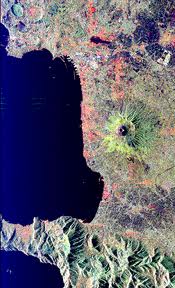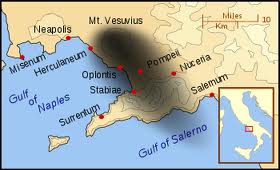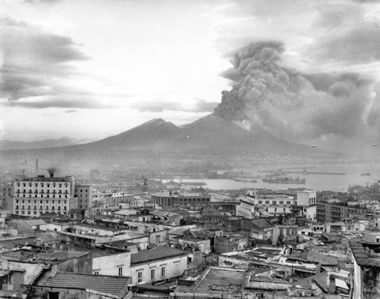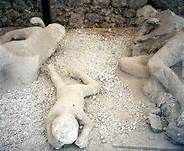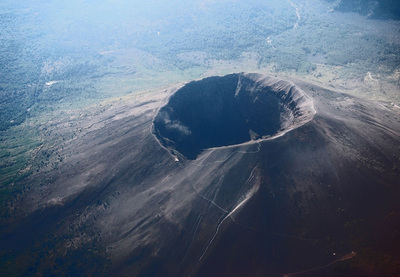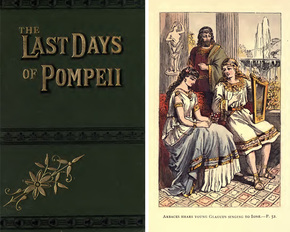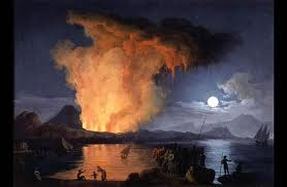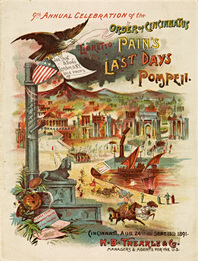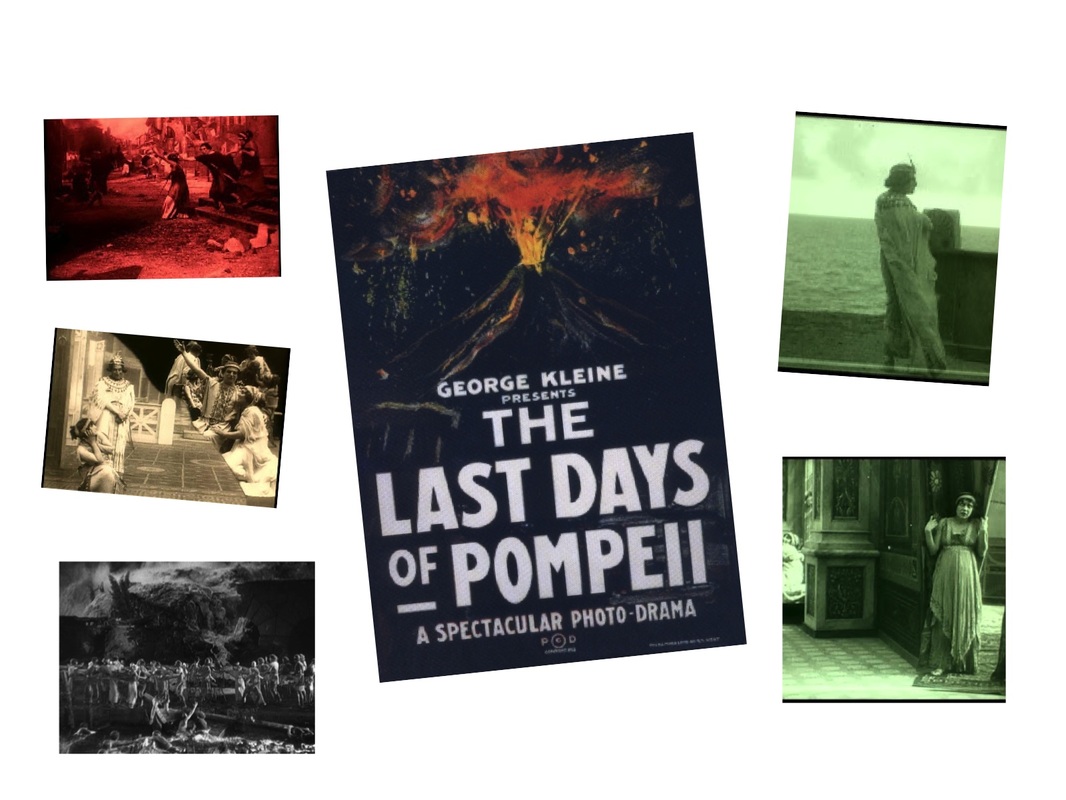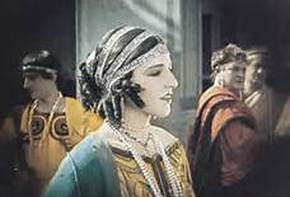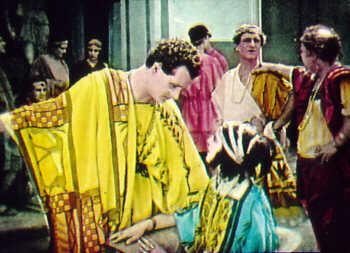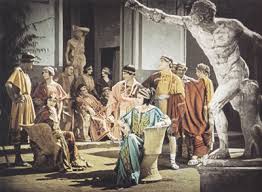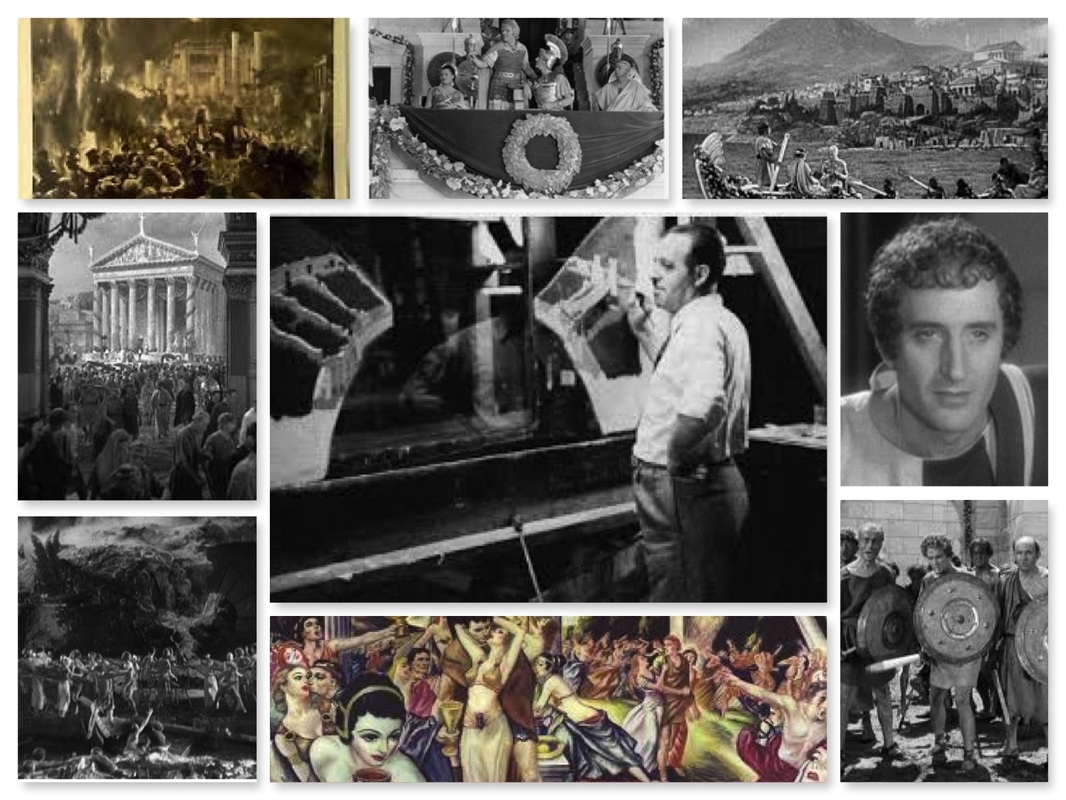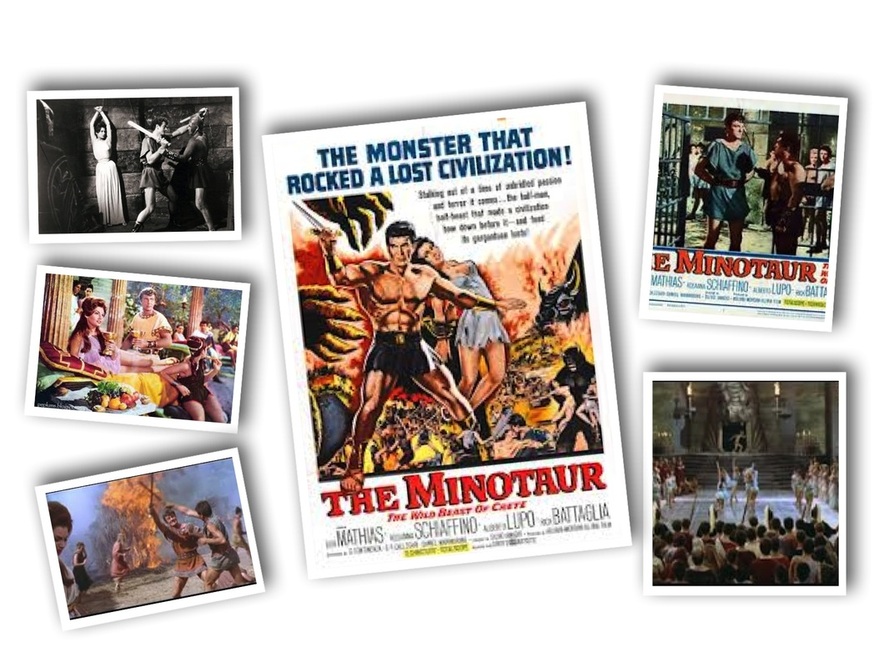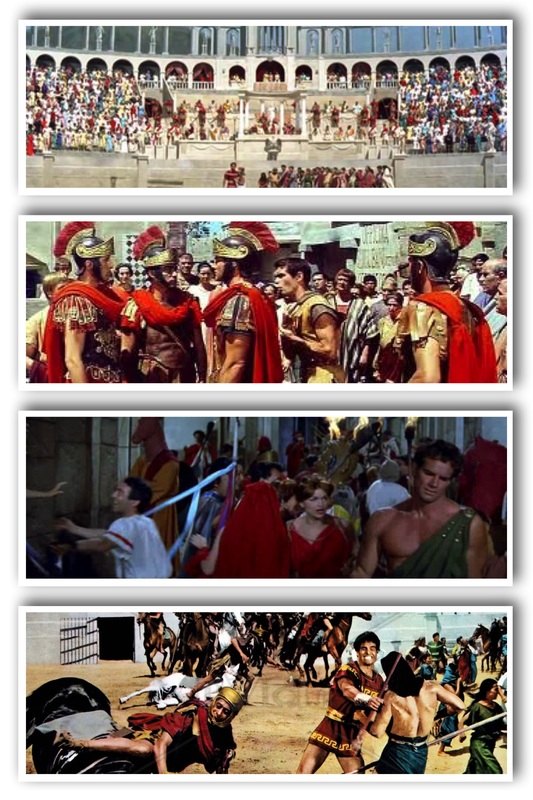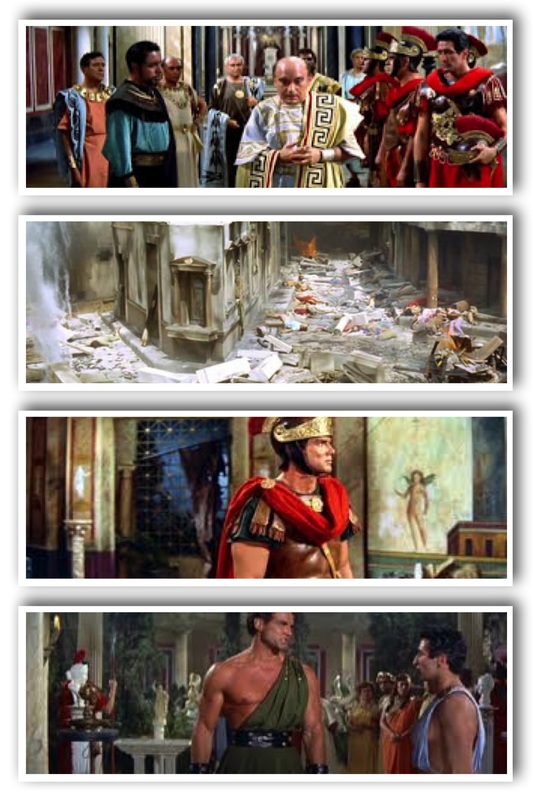Pompeii in the Movies
Paul W.S. Anderson's 2014 movie Pompeii (poster above) is the first 3D version of several that have portrayed the town's destruction almost two millenia ago. But it's just the latest in a subject that's been popular since the late eighteenth century. Pompeii's fate has featured in best-selling novels, poems, paintings, sculpture, and even 'pyrodrama'. It was the subject of a feature movie as early as 1908. Since then about a dozen feature films and TV adaptations have been made. The makers of King Kong produced one in the 1930s , a 1930 epic version almost bankrupted the Italian film industry and the great Sergio Leone directed some scenes in 1957's Last Days of Pompeii .
What's it all about?
About lunchtime on 29 August, 79 C.E. (Common Era i.e. 79 A.D.) the Roman town of Pompeii, a few miles inland from the Bay of Naples was destroyed when the nearby Mt. Vesuvius, a volcano inactive for nearly eight centuries, suddenly and violently erupted. A scalding hail of pumice and ash entombed those who were unable or unwilling to flee. Residents of the nearby coastal resort of Herculaneum suffered an even more horrible fate: buried under thirteen metres of boilng mud caused by torrentyial rain and super-hot steam mixing with ashes and flowing down the slopes of the mountain. The formerly bustling, crowded cities were destroyed, remaining undiscovered until the early 18th Century. Yet ironically their excavated ruins -buildings, artefacts, streets, entombed human and animal bodies, frozen in time - preserved an entire way of life, made visible again after centuries.
The fascination of disaster
The general public's fascination with the fate of Pompeii probably originated in the 1834 with the publication of a novel, The Last Days of Pompeii, by Edward Bulwer-Lytton, the Dan Brown of the Victorian age. Bulwer-Lytton was the man who also wrote the immortal lines "It was a dark and stormy night" and also coined the phrases "the pen is mightier than the sword," "the great unwashed" and "the almighty dollar". His Pompeii novel was tremendously popular and features not one but two interlocking romantic triangles, an evil, lustful priest, chaste heroines and pensive heroes, with a supporting cast of degenerate Romans, all set against a lurid backdrop of decadence and immorality. Like the modern world's scriptwriters and directors, the artists, sculptors, poets and stage managers of the nineteenth Century realised that here was a magnificent opportunity to depict unrequited lovers, violence, depravity and endangered young women sometimes struggling to retain their clothes and their virtue, plus the bonus of a spectacular eruption and its accompanying destruction. And depictions of violence, destruction and immorality could be justified on the grounds that the erurption proved that divine wrath punished bad behaviour.
So literally hundreds of lurid paintings, sculptures in the classical style, overwrought poems and even pyrodramas (plays with elaborate special-effects, especially tilting stages, collapsing props and simulated fires and explosions) attested to the popularity of Pompeii/ Mt. Vesuvius as a subject for most of the nineteenth century.
So literally hundreds of lurid paintings, sculptures in the classical style, overwrought poems and even pyrodramas (plays with elaborate special-effects, especially tilting stages, collapsing props and simulated fires and explosions) attested to the popularity of Pompeii/ Mt. Vesuvius as a subject for most of the nineteenth century.
Pompei and a century of movies
The Last days of Pompeii (1913): The first feature movie about Pompeii?
In 1913 an Italian studio produced The Last days of Pompeii, (directed by Eleuterio and Mario Caserini), a fairly faithful adaptation of Bulwer-Lytton's novel. This movie used the about to be superseded "tableau" formula i.e. a series of long, vitually static takes, with little or no camera movement. The movie had large, magnificent sets and elaborate exterior scenes and also, a cast of thousands including lions and tigers. Gladiators fight to the death, innocent maidens are threatened, villains preen and Mt.Vesuvius explodes. The film also uses the split-screen technique in some sequences, and a the shots of the volcano erupting and its devastating effects are tinted red. The movie was released in the USA - see poster below - hich raises an interesting question. Did D.W.Griffith see it ? Although Griffith moved away from Pompeii 's tableau technique, its epic scale, crowd scenes, endangered heroine, split screens, elaborate historical context and intercutting between scenes of the exploding Vesuvius and scenes of destruction and escape are echoed in such seminal Griffith movies as Birth of a Nation and Intolerance.
Below: scenes from the 1913 movie Last Days of Pompeii
Below: scenes from the 1913 movie Last Days of Pompeii
The 1926 Last Days of Pompeii
Once again, this was an Italian production, based on the famous novel. Directed by Carmine Galone and Amieto Palermi, this movie was an unsuccessful attempt to restore the status and profitability of the Italian movie industry. This lengthy film is best known for lavish costumes and sets, and large casts. Little expense was spared to ensure the authenticity of decorations, interiors and buildings that made up the sets of Pompeii. The original print was colorised i.e tinted by a new 'Pathechrome' process. Despite this,the movie failed at the box office.
The Last Days of Pompeii (1935): made by the team that gave the world King Kong
Two years after the success of King Kong, the same talented trio of Producer Merian C. Cooper, director Ernest B. Schoedsack and special effects wizard Willis O'Brien tried their hand at sword-and-sandals / disaster movie. Although the film received favorable reviews, especially for its impressive special effects, it failed to make a profit on its first release.
Unlike the previous versions, theirs dispensed with Bulwer-Lytton's plot and characters. Their plot featured a strange compression and distortion of the forty-five years between the crucifixion and the eruption.This enabled them to fit Pontius Pilate (Basil Rathbone in fine form) into the story, but which may have proved off-putting to audiences. The actual plot is rather good - much better than Bulwer-Lytton's - and its 'wronged worthy Romanbr gains redemption as gladiator' motif was lifted by the makers of Gladiator. The story focuses on Marcus, a blacksmith in Pompeii, whose wife and son are killed in an accident. Bitter than he was too poor to pay for the medical care that would have saved their lives, he decides to earn more money by fighting as a gladiator. Eventually he adopts an orphan, becomes an acquaintance of Pontius Pilate and works himself into a life of wealth and respectability, in charge of the gladiatorial arena. His now grown son Flavius is captured helping persecuted Christians and condemned to fight in the arena. At this stage Mt. Vesuvius starts runbling.....
Unlike the previous versions, theirs dispensed with Bulwer-Lytton's plot and characters. Their plot featured a strange compression and distortion of the forty-five years between the crucifixion and the eruption.This enabled them to fit Pontius Pilate (Basil Rathbone in fine form) into the story, but which may have proved off-putting to audiences. The actual plot is rather good - much better than Bulwer-Lytton's - and its 'wronged worthy Romanbr gains redemption as gladiator' motif was lifted by the makers of Gladiator. The story focuses on Marcus, a blacksmith in Pompeii, whose wife and son are killed in an accident. Bitter than he was too poor to pay for the medical care that would have saved their lives, he decides to earn more money by fighting as a gladiator. Eventually he adopts an orphan, becomes an acquaintance of Pontius Pilate and works himself into a life of wealth and respectability, in charge of the gladiatorial arena. His now grown son Flavius is captured helping persecuted Christians and condemned to fight in the arena. At this stage Mt. Vesuvius starts runbling.....
Scenes from the movie: Center picture shows work on one of the many matte paintings that featured in the movie; to right is Basil Rathbone, chillingly convincing as Pontius Pilate. Color illustration is part of the advertising campaign for the film.
'Peplum' movies
During the 1950s the'sword and sandals" movie genre had gained some respectability in the 1950s, with Hollywood lavishing money and big stars on Quo Vadis (1951) and Ben-Hur (1959), the latter achieving great box-office and Oscar success. In Europe such films were known as "peplum" movies, after the short tunics worn by the often muscle-bound male stars. During 1958 - 1963 about 170 such movies were made, most in Italy and Spain. These costume dramas were made cheaply and very quickly, and often employed American body-builder types or sports stars as their star. Their format was simple - a plot or characters often uplifted from mythology or classical literature, a husky hero who was often a soldier, warrior, guard etc, nasty villain with designs on the heroine, a torture scene, a feast -orgy, climactic battle. By the end of the fifties, according to Leone, peplum movies were "the most sought-after cinematic genre in the world." An Italian critic claimed they were "big, noisy and colourful machines constructed in the vein of strip cartoons."
The not-very-good 1960 movie The Minotaur: the Wild Beast of Crete, directed by Silvio Amadio, includes several common features of peplum movies - inckude an American as star (in thus case Bruce Mathias, the Olympic decathlete), an imperilled heroine,requiring rescue by the hero, a seductive temptress, a dungeon scene, a fight, a scheming villain, a banquet/dance/orgy, a monster, demon or supernatural being, . (see below)
The not-very-good 1960 movie The Minotaur: the Wild Beast of Crete, directed by Silvio Amadio, includes several common features of peplum movies - inckude an American as star (in thus case Bruce Mathias, the Olympic decathlete), an imperilled heroine,requiring rescue by the hero, a seductive temptress, a dungeon scene, a fight, a scheming villain, a banquet/dance/orgy, a monster, demon or supernatural being, . (see below)
Sergio Leone & The Last days of Pompeii (1959) in Supertotalscope with Steeve Reeves
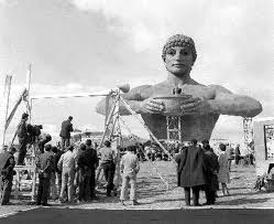 Sergio Leone at work on set of "Colossus of Rhodes".
Sergio Leone at work on set of "Colossus of Rhodes".
This version of Last Days of Pompeii was released the same year as Ben-Hur. It starred the then very popular American actor Steve Reeves, a champion bodybuilder turned movie star in Italian movies. Pompeii confirmed his popularity and during the first half of the 1960s he was one of the world's most popular actors in a series of films that were usually met with derision by critics, but which achieved worldwide popularity. Reeves was, in fact, the prototype for Arnold Schwarzenegger's career, which followed a similar trajectory.
However, this particular Last Days is now more notable for being a launching pad for the directing career of the great Sergio Leone. He had worked in movies for some years on second units (including both Quo Vadis and Ben-Hur) and was the second-unit director when filming began. But on the first day of shooting the movie's director Mario Bonnard fell seriously ill. Although some DVD versions of the film credit Leone as director, Leone became in charge of production and immediately hired Sergio Corbucci, a friend and out of work director to take over most of the direction. Leone explained later that "Some critics have written that my first film as a director was [Last Days of Pompeii]. But it wasn't . I didn't plan or conceive. I held it together." Leone did, however, diect the extended and violent opening sequence and another long and violent sequence set in a torture chamber.
The movie was a great success worldwide. Leone's reward was that he was given the opportunity to make his first feature film: Colossus Of Rhodes. His directorial career had now begun.
[Source: Christopher Frayling, Sergio Leone: something to do with death (London: 2000), pp.82-97.)
Above images from the movie show scenes from the movie. The hero is played by Steve Reeves, as a Roman centurion who returns home to find his family murdered, his home ransacked, and sets out to find the evil-doers and revenge his family.
Below is an entertaining trailer, unfortunately not in widescreen format.
Below is an entertaining trailer, unfortunately not in widescreen format.
